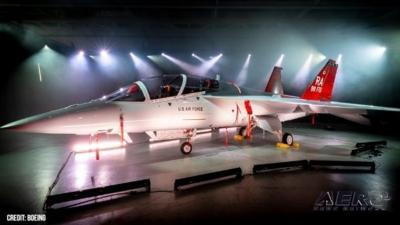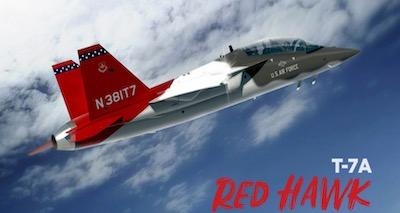Marks The Onset Of The T-7’S Engineering And Manufacturing Development Phase
A U.S. Air Force pilot departed Boeing’s St. Louis, Missouri facilities at the controls of a T-7A Red Hawk, thereby occasioning the commencement of USAF flight-testing of the service’s new, supersonic, advanced jet trainer.

The event, announced by Boeing, marks the onset of the T-7’s engineering and manufacturing development phase.
The tandem-seat jet was taken aloft for 63-minutes by Major Bryce Turner of the USAF’s 416th Test Squadron and Boeing T-7 chief test pilot Steve Schmidt. The pair verified the aircraft’s rudimentary flight characteristics, which Major Turner characterized favorably, setting forth in a post-flight statement the T-7 “performs like a fighter.”
The milestone flight was undertaken in aircraft 21-7005, the first of five aircraft provided by Boeing to support the Air Force’s T-7A test program. Boeing’s partner in the T-7 project, Saab of Sweden, builds much of the aircraft’s mid-fuselage and empennage sections.
Boeing, by virtue of two pre-production prototypes dubbed T-1 and T-2, won 2019’s T-X competition, eking out Leonardo’s T-100 and Lockheed-Martin/KAI’s T-50A submissions. The ensuing years have seen Boeing test pilots put the two prototype airframes through hundreds of hours of evaluation and proving flights.
Notwithstanding USAF General Mike Holmes—then head of Air Combat Command—having made a brief flight in one of the prototypes, the 28 June sortie stands as the first official Air Force flight of the T-7 insomuch as the aircraft flown by Major Turner was the first of the jet’s production configuration—which differs considerably from the T-1 and T-2 prototypes.
Boeing vice-president and T-7 program manager Evelyn Moore declared the first USAF-piloted T-7 flight speaks to Boeing’s “commitment to delivering a new level of safety and training for fighter and bomber pilots.”
Moore continued: “We remain focused on engineering ways to better prepare warfighters for changing mission demands and emerging threats.”
The official start of the T-7’s engineering and manufacturing development phase was delayed several months by complications with the aircraft’s ejection seat system.
In December 2022, USAF spokeswoman Major Alexandra Stormer somewhat vaguely attributed the T-7s' woes to the aircraft’s flight control software and the escape system. “All flight control software issues to date have been resolved and will be tested in flight in the first quarter of 2023,” Major Stormer remarked. “The Air Force is working to correct some escape system deficiencies found during initial testing in late 2021, and will resume escape system testing in the first quarter of 2023.”
The T-7, in point of fact, had fallen victim to de rigueur Pentagon policies. A 2020 report from McClatchy—a left-wing digital news service describing itself as “truth-teller(s) and protector(s) of independent voices”—tacitly impugned the Air Force for basing its aircraft cockpit and cockpit seat dimensions on the average physical measurements of USAF pilots circa 1960 through 1970. The practice, albeit eminently defensible, makes no allowances for heavier male pilots or smaller, less physically powerful, pilots. Ergo, the T-7 was designed to be more accommodating of different body sizes encompassing all pilots capable of meeting Air Force standards—which, in recent years, have been substantially relaxed.

Ensuring the T-7’s ejection system is capable of reliably blasting portly aviators and expectant mothers into the baleful blast of supersonic relative winds and murderous barometric differentials proved challenging, however.
The Air Force announced in October 2021 that it had started testing the T-7’s ejection system, reporting in a press release that its evaluations comprised “the largest-class and smallest-class manikins”—thereby taking into account the broad range of body types around which the jet is designed.
Regrettably, the U.S. Government Accountability Office’s (GAO) 2021 Weapon Systems Annual Assessment flagged qualification of the T-7’s ejection system as one of two primary risks to the program’s schedule. The GAO’s 2022 report called the Red Hawk’s ejection system a top program risk. “If the program experiences delays in qualifying the emergency escape system, there is increased risk of delay to the November 2023 production decision,” the report stated.
In addition to shortcomings with its ejection system, Air Force testing of the T-7 revealed a degree of aircraft wing rock—an unwanted self-induced rolling oscillation alternately attributable to wing planform, fuselage cross-section, and vertical stabilizer design.
In April 2023, Air Force acquisition executive Andrew Hunter advised Congress initial operational capability of the T-7 will not be achieved until 2027—three-years beyond the program's original 2024 target.
One month later, the GAO posited the T-7 program will fall even further behind the cumulative years of delays it’s already incurred.
Upon the T-7’s eventual emergence from its protracted gestation, the Air Force plans to acquire 351 specimens of the advanced training platform with which the service intends to replace its Kennedy-era T-38 Talons, many of which are over sixty-years-old and, owing to T-7 program delays, now require further costly and dangerous life extension measures.

The Air Force zeroed its 2024 funding request for T-7 production on the assumption the ejection seat issue would preclude production of the aircraft. The service has yet to indicate whether it will request a reprogramming of funds for that purpose. The Air Force’s fiscal 2024 request included a forecast of 94 T-7s to be purchased over the next five years, at a cost of $2.205-billion.
The next milestone toward which the T-7 program will saunter is the Low Rate Initial Production (LRIP) decision, currently expected to be made by Pentagon acquisition and sustainment chief William LaPlante in November 2023. The GAO pointed out, however, that the Air Force will likely be unable to move ahead with LRIP insomuch as November will find flight-testing of the T-7 still in its early stages and details of the program’s requirements and production contract yet to be ironed out. The GAO questioned, also, whether the Air Force may legally accept jets ordered prior to the setting of finalized specifications.
Boeing maintains T-7 program delays are attributable, in part, to supply chain breakdowns, labor issues, and inflation. The plane-maker is developing the T-7 under a fixed-price contract which, if fully exercised, is valued at approximately $9.2-billion.
 ANN's Daily Aero-Term (05.10.24): Takeoff Roll
ANN's Daily Aero-Term (05.10.24): Takeoff Roll Aero-News: Quote of the Day (05.10.24)
Aero-News: Quote of the Day (05.10.24) Aero-News: Quote of the Day (05.11.24)
Aero-News: Quote of the Day (05.11.24) ANN's Daily Aero-Term (05.11.24): IDENT Feature
ANN's Daily Aero-Term (05.11.24): IDENT Feature ANN's Daily Aero-Linx (05.11.24)
ANN's Daily Aero-Linx (05.11.24)





